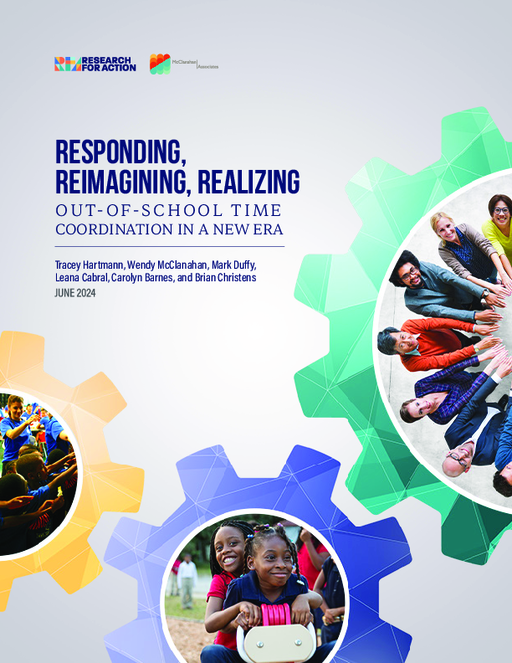- Author(s)
- Tracey Hartmann, Wendy McClanahan, Mark Duffy, Leana Cabral, Carolyn Barnes, and Brian Christens
- Publisher(s)
- Research for Action and McClanahan Associates
Research Approach
This study explored how OST coordination in each of the three nested systems (within the citywide OST system, across the L&D Ecosystem and outside of the L&D Ecosystem) changed in response to the COVID-19 pandemic and urgent calls to address racial inequality. The study aimed to answer three central research questions:
How, if at all, did OST coordination change to address emerging community needs and racial and economic disparities exacerbated by the pandemic?
What OST coordination functions were seen as most critical, or most in need of change, for advancing racial equity in the OST system?
What were OST stakeholders’ perceptions of the value of OST coordination during the pandemic, and what types of coordination did they perceive to be most useful?
To answer these questions, the researchers designed a three-phase qualitative study to understand the national landscape of OST coordination and support sampling (Phase 1), conduct in-depth case studies on the role and contributions of OST Coordinating Entities (OST CEs) during the pandemic (Phase 2), and understand provider and caregiver perspectives on OST coordination (Phase 3).
Each phase of the research is described below.
To answer these questions, we designed a three-phase qualitative study to understand the national landscape of OST coordination and support sampling (Phase 1), conduct in-depth case studies on the role and contributions of OSTIs during the pandemic (Phase 2), and understand provider and caregiver perspectives on OST coordination (Phase 3). Each phase of the research is described below.
Phase 1. Understanding the landscape, selecting cities for Phase 2, and conducting a federal policy scan: This phase included interviews with national experts to collect background information and input on the study design and select an initial sample of 20 cities. The research team then conducted leadership interviews with an OSTI staff leader in each of the 20 sample cities to better understand the variation in OST coordination shifts in response to the pandemic and the L&D ecosystem overall. The research team coded these interviews in Dedoose and conducted thematic analysis by topic area. This analysis, as well as a document review and a preliminary state and federal policy scan, informed the selection of 12 cities to participate in Phase 2 of the research. Phase 1 was conducted in 2021 and early 2022.
Phase 2. Understanding the shifts in OST coordination during the pandemic, what was most valued, and how issues of equity influenced the sector: In Phase 2 the research team conducted in-depth case study research in 12 cities to inform our understanding of the L&D ecosystem, the citywide OST system, and the policy landscape. In each of the 12 Phase 2 cities, the research team conducted interviews or focus groups with OSTI staff, city government staff, school district staff, funders, OST coordination partners, state OST network representatives, and providers. Table 2 displays the total number of each type of interview conducted across the 12 cities.
Phase 3. Examining how OST coordination builds capacity, addresses equity, and forms strong OST networks: The third phase of the research explored the configuration and strength of OST networks and the perspectives of caregivers in a subset of six Phase 2 cities. Phase 3 data collection included a survey of providers (N=163 total, with respondents per city ranging from 14 to 59) to explore their perspectives on the extent to which their city’s OST sector is networked (i.e., connections, teamwork, and communication among providers) and how the network changed over time, perceptions of the value of supports provided by the OSTI, and the extent to which the network worked together to address racial equity over time. The characteristics of inter-organizational relationships and networks are likely related to the collective capacity of organizations in a city to work together to adapt and accomplish shared goals generally and in times of stress. Phase 3 also included in-depth interviews with caregivers1 to gather families’ perspectives on how the OST sector has supported them during the pandemic, any perceived gaps in services, and whether they view the sector’s responses as equitable. Preliminary findings for the provider survey and caregiver interviews are included throughout this report and more detailed findings will be released in the future.
One limitation of the research was that the 12-city CE sample was not necessarily representative of the full range of OST coordination in cities across the United States. At the same time, the study’s robust dataset makes it one of the largest and most comprehensive studies to date on OST coordination activities during the pandemic.
- 1 Preliminary findings shared in this report are based on 49 interviews with caregivers conducted in 2023 but interviews are on-going.

